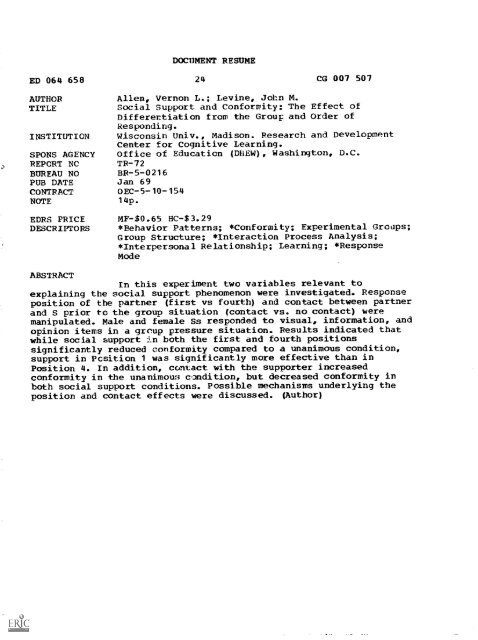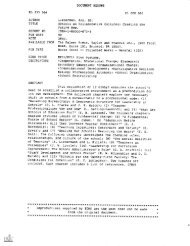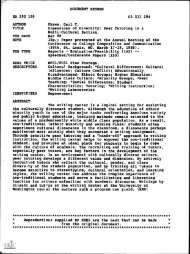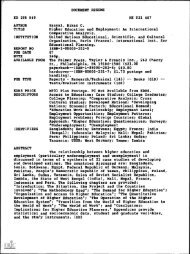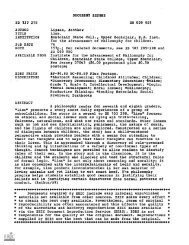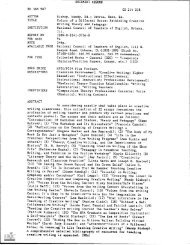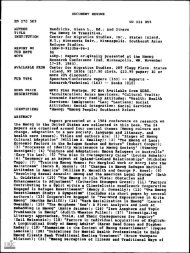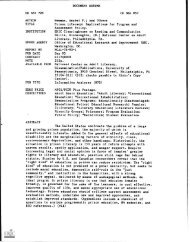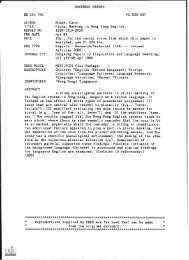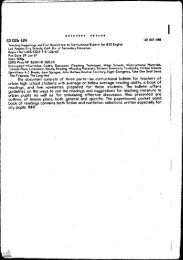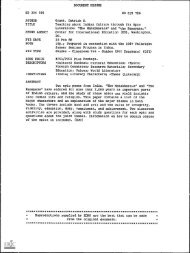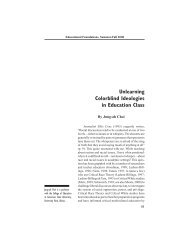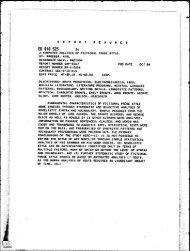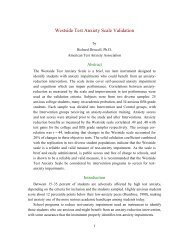Social Support and Conformity: The Effect of Differentiation from the ...
Social Support and Conformity: The Effect of Differentiation from the ...
Social Support and Conformity: The Effect of Differentiation from the ...
You also want an ePaper? Increase the reach of your titles
YUMPU automatically turns print PDFs into web optimized ePapers that Google loves.
DOCUMENT RESUMEED 064 658AUTHORTITLEINSTITUTIONSPONS AGENCYREPCRT NCBUREAU NOPUB DATECONTRACTNOTEEDRS PRICEDESCRIPTORS24 CG 007 507Allen, Vernon L.; Levine, John M.<strong>Social</strong> <strong>Support</strong> <strong>and</strong> <strong>Conformity</strong>: <strong>The</strong> <strong>Effect</strong> <strong>of</strong>Differertiation <strong>from</strong> <strong>the</strong> Group <strong>and</strong> Order <strong>of</strong>Responding.Wisconsin Univ., Madison. Research <strong>and</strong> DevelopmentCenter for Cognitive Learning.Office <strong>of</strong> Education (DHEW), Washington, D.C.TR-72BR-5-0216Jan 69OEC-5-10-15414p.MF-$0.65 HC-$3.29*Behavior Patterns; *<strong>Conformity</strong>; Experimental Groups;Group Structure; *Interaction Process Analysis;*Interpersonal Relationship; Learning; *ResponseModeABSTRACTIn this experiment two variables relevant toexplaining <strong>the</strong> social support phenomenon were investigated. Responseposition <strong>of</strong> <strong>the</strong> partner (first vs fourth) <strong>and</strong> contact between partner<strong>and</strong> S prior to <strong>the</strong> group situation (contact vs. no contact) weremanipulated. Male <strong>and</strong> female Ss responded to visual, information, <strong>and</strong>opinion items in a grcup pressure situation. Results indicated thatwhile social support :Ln both <strong>the</strong> first <strong>and</strong> fourth positionssignificantly reduced conformity compared to a unanimous condition,support in Pcsition 1 was significantly more effective than inPosition 4. In addition, contact with <strong>the</strong> supporter increasedconformity in <strong>the</strong> unanimous condition, but decreased conformity inboth social support conditions. Possible mechanisms underlying <strong>the</strong>position <strong>and</strong> contact effects were discussed. (Autlxn)
STATEMENT OF FOCUS<strong>The</strong> Wisconsin Research <strong>and</strong> Development Center for Cognitive Learningfocuses on contributing to a better underst<strong>and</strong>ing <strong>of</strong> cognitive learning bychildren <strong>and</strong> youth <strong>and</strong> to <strong>the</strong> improvement <strong>of</strong> related educational practices.<strong>The</strong> strategy for research <strong>and</strong> development is comprehensive. It includesbasic research to generate new knowledge about <strong>the</strong> conditions <strong>and</strong> processes<strong>of</strong> learning <strong>and</strong> about <strong>the</strong> processes <strong>of</strong> instruction, <strong>and</strong> <strong>the</strong> subsequent development<strong>of</strong> research-based instructional materials, many <strong>of</strong> which are designed foruse by teachers <strong>and</strong> o<strong>the</strong>rs for use by students. <strong>The</strong>se materials are tested <strong>and</strong>refined in school settings. Throughout <strong>the</strong>se operations behavioral scientists,curriculum experts, academic scholars, <strong>and</strong> school people interact, insuringthat <strong>the</strong> results <strong>of</strong> Center activities are based soundly on knowledge <strong>of</strong> subjectmatter <strong>and</strong> cognitive learning <strong>and</strong> that <strong>the</strong>y are applied to <strong>the</strong> improvement <strong>of</strong>educational practice.This Technical Report is <strong>from</strong> <strong>the</strong> Peer Group Pressures on Learning Projectin Program 1. General objectives <strong>of</strong> <strong>the</strong> Program are to generate new knowledgeabout concept learning <strong>and</strong> cognitive skills, to syn<strong>the</strong>size existing knowledge,<strong>and</strong> to develop educational materials suggested by <strong>the</strong> prior activities. Contributingto <strong>the</strong>se Program objectives, ihis project is directed toward identification<strong>of</strong> <strong>the</strong> effects <strong>of</strong> peer group pressures on <strong>the</strong> utilization <strong>of</strong> concepts alreadylearned <strong>and</strong> on <strong>the</strong> learning <strong>of</strong> new concepts.iii
CONTENTSpageList <strong>of</strong> TablesAbstractviviiI. Introduction 1II. Method 3Design 3Subjects 3Apparatus 3Procedure 3Stimuli 4Method <strong>of</strong> Analysis 4III. Results 5Perception <strong>of</strong> Dissenter's Position 5<strong>Conformity</strong> 5Evaluation <strong>of</strong> <strong>the</strong> <strong>Support</strong>er 6IV. Discussion 7References 84
LIST OF TABLESTable1Proportion <strong>of</strong> Ss Perceiving Ano<strong>the</strong>r Group MemberFrequently Agreeing with <strong>The</strong>mAnalysis <strong>of</strong> Variance on Mean <strong>Conformity</strong> Scorespage53Mean <strong>Conformity</strong> Scores as a Function <strong>of</strong> Contactin <strong>the</strong> Three Conditions 6vi
ABSTRACTIn this experiment two variables relevant to explaining th(. social supportphenomenon were investigated. Response position <strong>of</strong> <strong>the</strong> partner (first vs.fourth) <strong>and</strong> contact between partner <strong>and</strong> S prior to <strong>the</strong> group situation (contactvs. no contact) were manipulated. Male <strong>and</strong> female Ss responded to visual,information, <strong>and</strong> opinion items in a group pressure situation. Results indicatedthat while social support in both <strong>the</strong> first <strong>and</strong> fourth positions significantlyreduced conformity compared to a unanimous condition, support in PositionI was significantly more effective than in Position 4. In addition, contactwith <strong>the</strong> supporter increased conformity in <strong>the</strong> unanimous condition, but decreasr.dconformity in both social support conditions. Possible mechanismsunderlying <strong>the</strong> position <strong>and</strong> contact effects were discussed.VII
INTRODUCTIONSeveral recent investigations (Allen &Levine, 1968a, 1968b, in press) have supportedAsch's (1951) conclusion that <strong>the</strong>presence <strong>of</strong> one person, answering before <strong>the</strong>naive S <strong>and</strong> correctly dissenting <strong>from</strong> erroneousgroup consensus, reduces conformitysignificantly compared to a unanimous group.<strong>The</strong> present study was designed to investigatetwo unexplored variables <strong>of</strong> potential<strong>the</strong>oretical utility in explaining <strong>the</strong> socialsupport phenomenon. <strong>The</strong>se variables are,first, response position <strong>of</strong> <strong>the</strong> partner, <strong>and</strong>,second, brief interaction between S <strong>and</strong> <strong>the</strong>partner.In studies <strong>of</strong> <strong>the</strong> effectiveness <strong>of</strong> socialsupport in reducing conformity, typically <strong>the</strong>social supporter has answered fourth <strong>and</strong> <strong>the</strong>S has answered fifth (last) in a group <strong>of</strong> fivepersons (Allen & Levine, 1968a, 1968b, inpress). Whe<strong>the</strong>r, however, it is crucial forconformity reduction that <strong>the</strong> social supporterrespond immediately prior to S, <strong>and</strong>, hence,after <strong>the</strong> o<strong>the</strong>r group members, is open toquestion. Let us examine two social supportsituationspartner answering in ei<strong>the</strong>r firstposition or fourth positionto determinefactors which may differentially affect conformityreduction. As will be seen, plausiblepredictions <strong>of</strong> relatively greater conformityreduction can be advanced for ei<strong>the</strong>r answeringposition.<strong>The</strong> position in which <strong>the</strong> social supporterresponds may influence <strong>the</strong> "gestalt" <strong>of</strong> <strong>the</strong>situation, as perceived by S. That is, S mayattribute varying psychological interpretationsto <strong>the</strong> relation between <strong>the</strong> supporter <strong>and</strong> <strong>the</strong>group, depending on <strong>the</strong> ordinal answeringposition <strong>of</strong> <strong>the</strong> partner. When <strong>the</strong> social supporteranswers first, followed by three opposingresponders, S may attribute maximumvalidity to <strong>the</strong> partner's responses. For onlyindependent assessment <strong>of</strong> <strong>the</strong> stimuli, unfetteredby group pressure, determined <strong>the</strong>partner's judgment. Responses <strong>of</strong> <strong>the</strong> socialsupporter answering fourth, though correct orpopular, may be perceivA as partially determinedby <strong>the</strong> group, i.e., <strong>the</strong> partner may bemerely an anticonformer. Thus, S may attributegreater credibility to <strong>the</strong> supporter answeringfirst, ra<strong>the</strong>r than fourth. However, <strong>the</strong> partnerresponding fourth, though relatively low incredibility, has ano<strong>the</strong>r potential advantagethat may enhance his effectiveness in reducingconformity. Subjects may attribute greatercorerage to <strong>the</strong> later supporter because hebravely st<strong>and</strong>s up against three unanimouslyopposing gr)up members. This courage, inturn, may create a positive impression <strong>of</strong> <strong>the</strong>supporter that will increase his ability to freeS <strong>from</strong> group pressure. In sum, <strong>the</strong> supporterin position four will be seen as more courageous,while <strong>the</strong> supporter in position one willbe seen as more credible. Recent data on <strong>the</strong>importance <strong>of</strong> independent assessment <strong>of</strong> realityin social support (Allen & Levine, inpress) lead to <strong>the</strong> prediction that a partnerwho responds first will be more effective inreducing conformity than will a partner whoresponds fourth.Turning now to <strong>the</strong> second variable underinvestigation in this study, let us examine<strong>the</strong> potential influence on conformity reduction<strong>of</strong> a brief interaction between supporter <strong>and</strong>S prior to <strong>the</strong> experiment. In <strong>the</strong> ordinary socialsupport situation, <strong>the</strong> partner is not differentiated<strong>from</strong> <strong>the</strong> o<strong>the</strong>r group member; i.e.,S nei<strong>the</strong>r knows <strong>the</strong> identity <strong>of</strong> <strong>the</strong> partnernor interacts with him. However, it seemshkely that contact <strong>and</strong> mutual awareness betweenS <strong>and</strong> <strong>the</strong> supporter might produce apsychological situation for S having implicationsfor <strong>the</strong> supporter's efficacy in reducingconformity. Firt, S's usual degree <strong>of</strong> anonymity)n <strong>the</strong> group pressure situation is reducedby <strong>the</strong> presence <strong>of</strong> one person whoknows his identity (<strong>and</strong>, as will be discussedlater, his answering position). As researchhas consistently demonstrated (Deutsch &Gerard, 1955; Asch, 1956; Levy, 1960), conformityto a unanimous group varies directlywith publicness <strong>of</strong> response. That is, S'sresponses are closer to group consensus when1
ide:.tity <strong>and</strong> answers ary open to groupu iinihir veii i . th.:iefory, itmidnt bt 1;ipufnY1512l.A. tnt. if S S rt2:;po1isestif motatoled by only one gloup Inembel, Sill 1.-nd to rt,spond similarly to thy observer.coueetly dissents nom error.,nus group ednsensusS will also tend todisbent.byLulhae ul iutuil oW0ILht.:66uh(z intezaction. S <strong>and</strong> <strong>the</strong> supporter are differentiatedho<strong>of</strong> <strong>the</strong> o<strong>the</strong>rwise mutually anonymousdroup. his Cxplanation rests more onIt.ciprocol relation between S <strong>and</strong> <strong>the</strong> partnyithan does <strong>the</strong> anonymity explanation above.llety, we az y suggesting that <strong>the</strong> brief interactioncreates a "minimal" relationship betweenS <strong>and</strong> <strong>the</strong> partner which might influenceS's response in <strong>the</strong> group pressure situation.This relation might create, for instance, afelt obligation on <strong>the</strong> part <strong>of</strong> S to support <strong>the</strong>individual who correctly dissented <strong>from</strong> <strong>the</strong>group. Or, perhaps, <strong>the</strong> relation might producein S a feeling <strong>of</strong> accountability or re-:31-)01:b1h1l1;y ;;I:; l'Slttlutluh. Iflib latt-1 notion 15 closelylated to thy concept <strong>of</strong> "individuation" it:Itoducedby I.-stinget. Pepitune, <strong>and</strong> :\ewt.-01:;1,(10) <strong>and</strong> recyntly investigated by Sin.rez.Brusn. <strong>and</strong> Lublin (I'lt,-)). Since S <strong>and</strong> <strong>the</strong>supporter are ryciplocally individuated, S'sfeelings <strong>of</strong> responsibility may be heightenedby thy suppoltyr's aceyptancy 01 pk.isonalaccountability. correct dissent <strong>from</strong> elroneousgroup consensus. Thus, <strong>the</strong> oilleier,-tiation xplanation. like thy anonymity hypo<strong>the</strong>sisabove, predicts reduced conformity whenS <strong>and</strong> <strong>the</strong> supporter interact prior to <strong>the</strong> grouppressure situation.In <strong>the</strong> present experiment, we shall investigate<strong>the</strong> influence <strong>of</strong> ( I) partner's responseposition <strong>and</strong> ( 2) interaction betweenS <strong>and</strong> <strong>the</strong> partner on conformity reduction in<strong>the</strong> social support situation. It is hypo<strong>the</strong>sizedthat social support in position one<strong>and</strong> S-partner interaction will produce <strong>the</strong>greatest reductions in conformity.
IIMETHODDESIGNA repeated measures analysis <strong>of</strong> variancedesign was used. <strong>The</strong> between Ss factorswere: Conditions (Unanimous, <strong>Social</strong> <strong>Support</strong>4, <strong>Social</strong> <strong>Support</strong> 1), Contact (Contact, NoContact), <strong>and</strong> Sex <strong>of</strong> S (Male, Female). <strong>The</strong>within Ss factor was Type <strong>of</strong> Item (Visual,Information, Opinion).In <strong>the</strong> Unanimous condition, <strong>the</strong> (simulated)Ss who answered in <strong>the</strong> first four positionsagreed on each item. On critical pressuretrials, <strong>the</strong> group gave answers placed at<strong>the</strong> 95th percentile <strong>of</strong> responses given by ast<strong>and</strong>ardization group answering alone,' Onkiller trials <strong>the</strong> group gave modal or correctanswers, also obtained <strong>from</strong> <strong>the</strong> st<strong>and</strong>ardizationgroup. In <strong>the</strong> <strong>Social</strong> <strong>Support</strong> conditions,one simulated S. answering ei<strong>the</strong>r first orfourth in <strong>the</strong> group <strong>of</strong> five, dissented <strong>from</strong><strong>the</strong> erroneous responses <strong>of</strong> <strong>the</strong> three o<strong>the</strong>rsimulated Ss on critical trials by givingmodal or correct answers. On filler trials,<strong>the</strong> supporter agreed with <strong>the</strong> three simulatedSs.In <strong>the</strong> Contact groups each S interactedbriefly, prior to <strong>the</strong> experiment, with a confederatewho posed as ano<strong>the</strong>r S. In <strong>the</strong> NoContact groups. Ss did not meet or interactwith <strong>the</strong> confederate. Male <strong>and</strong> female Sswere tested in same-sex groups in ezIch <strong>of</strong><strong>the</strong> four experimental conditions describedabove. All Ss saw <strong>the</strong> same stimulus seriesconsisting <strong>of</strong> three types <strong>of</strong> items.'For information <strong>and</strong> opinion items, <strong>the</strong>stanciorclizDtion group was 300 introductorypsychology students who had filled out questionnairesin class. For visual items, <strong>the</strong>st<strong>and</strong>ardization group was introductory psychologystudents tested by Tuddenham, Macbride.<strong>and</strong> Zahn (1956).SUBJECTS<strong>The</strong> Ss were 276 undergraduates, 140males <strong>and</strong> 136 females, taking an introductorypsychology course at <strong>the</strong> University <strong>of</strong>Wisconsin. Data <strong>from</strong> 21 Ss were discardedbecause <strong>of</strong> <strong>the</strong>ir knowl2dge <strong>of</strong> <strong>the</strong> experimentaldeception, leaving a total <strong>of</strong> 255 Ss (123males <strong>and</strong> 132 females). <strong>The</strong> Ss receivedcredits applicable to thcir class grade forparticipating in <strong>the</strong> experiment.APPARATUS<strong>The</strong> apparatus was a Crutchfield-typeelectrical signaling device (Crutchfield, 1955),consisting essentially <strong>of</strong> five adjacent boothscontaining signal lights <strong>and</strong> answer switches,<strong>and</strong> a master control panel in an adjoiningroom. Subjects are led to believe, by instructionsarid practice trials, that signal lights in<strong>the</strong>ir booths indicate responses <strong>of</strong> o<strong>the</strong>r groupmembers <strong>and</strong> that one person responds in each<strong>of</strong> t:ie five answering positions. Actually, <strong>the</strong>first four lights in all booths are controlledby E <strong>from</strong> <strong>the</strong> master control panel, <strong>and</strong> allSs answer last (fifth) on all trials. Thus, Ecan provide simulated group responses thatagree or disagree with Ss' private judgments.PROCEDUREContact GroupsSubjects were taken separately to privateresearch rooms where <strong>the</strong>y were left to fillout adjective checklists prior to <strong>the</strong> experiment.After about 5 minutes, E returned toS's room with ano<strong>the</strong>r S (actually, a confederate)who was told to fill out <strong>the</strong> checklis<strong>the</strong>re while F. searched for a vacant room.(<strong>The</strong> confederate had been instructed to initiateno conversation <strong>and</strong> to tactfully refrain3
<strong>from</strong> discussion initiated by S during K's absence.)<strong>The</strong> E left <strong>and</strong> zeturned about 5 nw.-utes later, stating that a room was availablefor <strong>the</strong> confederate. <strong>The</strong> E <strong>the</strong>n informedboth S <strong>and</strong> <strong>the</strong> confederate <strong>of</strong> <strong>the</strong>ir answeringpositions in <strong>the</strong> following experimentalIn <strong>the</strong> <strong>Social</strong> <strong>Support</strong> 4 <strong>and</strong> Unanimous condi-Lions, <strong>the</strong> confederate was told to answerfouith in <strong>the</strong> group <strong>of</strong> five. In <strong>the</strong> <strong>Social</strong> <strong>Support</strong>1 condition, <strong>the</strong> confederate was instructedto respond first. <strong>The</strong> confederate always repeatedhis (her) answering position aloud, toinsure that S had noticed it. In all three conditionsS was told to answer last (fifth). <strong>The</strong>confederate was <strong>the</strong>n taken to ano<strong>the</strong>r S until<strong>the</strong> sequence had been repeated with all fournaive Ss. Finally, <strong>the</strong> four Ss <strong>and</strong> <strong>the</strong> confederatewere taken to <strong>the</strong> experimental room.No Contact GroupsFive naive Ss were taker. toge<strong>the</strong>r directly<strong>from</strong> <strong>the</strong> waiting room to <strong>the</strong> experimentalroom.After being seated in <strong>the</strong> five 1.Jooths in<strong>the</strong> experimental room, Ss were instructed tomake accurate judgments <strong>of</strong> perceptual, information,<strong>and</strong> opinion items projected on ascreen in <strong>the</strong> front <strong>of</strong> <strong>the</strong> room. Instructions<strong>and</strong> practice trials were utilized to familiarizeSs with use <strong>of</strong> <strong>the</strong> apparatus <strong>and</strong> to convinceSs that signal lights actually indicated lesponses<strong>of</strong> all group members. <strong>The</strong> E <strong>the</strong>npresented a series <strong>of</strong> 30 stimulus slides.simulating <strong>the</strong> first four responses on eachtrial. At <strong>the</strong> completion <strong>of</strong> <strong>the</strong> experiment, Ssfilled out a postexperimental questionnaire.A careful debriefing followed.STIMULI<strong>The</strong> 30 items used in this experimentwere selected <strong>from</strong> a series developed byN ; gulledamon:lengths <strong>of</strong> nine comparison lines .31::stEdc;: ,:1 , fa number below one <strong>of</strong> tne nino panel switcnos.Information items dealt \Nun iLlativelyfactual quostions,tron:Francisco to New York. Again, <strong>the</strong>se itymswen.: answered using th: numb,:tsbeneath <strong>the</strong> panel switcncs. Opinion itemsconsisted. <strong>of</strong> such statem,2nts as "I wouldnever go out <strong>of</strong> rny way to help ano<strong>the</strong>r peisonif it meant diving u;,) some personal pl:.,:sure"<strong>and</strong> "Mo...t young peeple get too mucheducation." <strong>The</strong>se items w,)re answered byusing one <strong>of</strong> Me nine labels located below<strong>the</strong> switches, ranging <strong>from</strong> Very StronglyAgree" to "Very Strongly Disagree."Of <strong>the</strong> 30 items used, 12 (40%) were critical,or grc-.;up pressure, itemsfour each <strong>of</strong>visual, information, <strong>and</strong> opinion items balancedover <strong>the</strong> series. <strong>The</strong> remaining 18 stimuli,6 <strong>of</strong> each type, were neutral filler items.METHOD OF ANALYSISFor each S a mean conformity score wascalculated separately for visual, information,<strong>and</strong> opinion items. Mean conformity scoreswere computed by summing <strong>the</strong> algebraic differencesbetween initial responses <strong>and</strong> responsesgiven in <strong>the</strong> group situation <strong>and</strong>dividing by <strong>the</strong> number <strong>of</strong> items used. (Forinformation <strong>and</strong> opinion items, initial scoreswere obtained <strong>from</strong> questionnaires Ss filledout in class several weeks prior to <strong>the</strong> experiment.For visual items, modal respoi..es <strong>of</strong>thr -uddenham et al. (1956) st<strong>and</strong>ardizationgr weie used.)4
IIIRESULTSPERCEPTION OFDISSENTER'S POSITIONSu o s._; <strong>of</strong> <strong>the</strong> expeiiirn..ntal manipulauonis partially reflectue in <strong>the</strong> k:ccuracy <strong>of</strong> Ss'per(eption <strong>of</strong> tne dissenter's arr Neting position.Tble I shows <strong>the</strong> !)lopor,.ion <strong>of</strong>each condition who pef ceived ano<strong>the</strong>r groupmember as frequently .1greeing with <strong>the</strong>m.(<strong>The</strong>se data ore based on responses fo <strong>the</strong>postexperimental questionnaire.) Inspection<strong>of</strong> Table 1 indicates that Ss in both <strong>the</strong> <strong>Social</strong><strong>Support</strong> 4 <strong>and</strong> <strong>Social</strong> <strong>Support</strong> 1 conditionsaccurately perceived <strong>the</strong> presence <strong>and</strong> position<strong>of</strong> <strong>the</strong> dissenter (.66 <strong>and</strong> .61, respectively),while Ss in <strong>the</strong> Unanimous condition rarelyperci wed ei<strong>the</strong>r POIson 1 or P'_J1son 4 as frequentlyagreeing witn <strong>the</strong>m (.07). Moreover,it is clear that <strong>the</strong> illsvering position <strong>of</strong> <strong>the</strong>dissenter in <strong>the</strong> two social support conditionsdid not differentially affect correct identification(.66 vs. .61). In addition, it appearsthat correct ..irentificatin <strong>of</strong> <strong>the</strong> social supporterdiffered huh_ in <strong>the</strong> Contact <strong>and</strong> NoContact conditions (.71 vs. .66 <strong>and</strong> .64 vs..55). As might be expected. however, Ss whohad interacted with <strong>the</strong> confederate (Contact)were slightly more aware <strong>of</strong> <strong>the</strong> supporter'sposition than were Ss in <strong>the</strong> No Contact condition.CONFORMITYTable 2. presents <strong>the</strong> analysis <strong>of</strong> varianceconducted on mean conformity scores. Both<strong>the</strong> Conditions <strong>and</strong> Items main effects weresignificant at less than <strong>the</strong> .01 level. Moreover,<strong>the</strong> Conditions x Contact <strong>and</strong> Items xSex <strong>of</strong> S interactions were significant beyond<strong>the</strong> .05 <strong>and</strong> .01 levels, respectively.Mean conformity scores in <strong>the</strong> Unanimous,<strong>Social</strong> <strong>Support</strong> 4, <strong>and</strong> <strong>Social</strong> <strong>Support</strong> 1 conditionsfor <strong>the</strong> Contact <strong>and</strong> No Contact groupsare presented in Table 3. Subsequent testson overall condition means indicate that conformityin both <strong>the</strong> <strong>Social</strong> <strong>Support</strong> 4 (.45) <strong>and</strong><strong>Social</strong> <strong>Support</strong> 1 (.31) conditions is significantlylower than in <strong>the</strong> Unanimous condition(.90) (t = 6.89, P< .01, <strong>and</strong> t = 8.97, p < .01,respectively). In addition, social support inposition 1 (.31) produces a significantlygreater decrease in conformity than does socialsupport given immediately before S'sresponse (.45) (t 2.08, p < .05).Regarding <strong>the</strong> significant Conditions xContact interaction, it is clear <strong>from</strong> Table 3that <strong>the</strong> effect <strong>of</strong> contact on conformity variedas a function <strong>of</strong> degree <strong>of</strong> group ananimity.That is, in <strong>the</strong> Unanimous condition Ss whointeracted with <strong>the</strong> confederate conformedmore than did those who had no contact (.99Table 1. Proportion <strong>of</strong> Ss Perceiving Ano<strong>the</strong>r Group MemberFrequently Agreeing with <strong>The</strong>mCondition Contact No Contact CombinedUnanimous<strong>Social</strong> <strong>Support</strong> 4<strong>Social</strong> <strong>Support</strong> 1927984.05 .07 .07.71 .66 .66.64 .55 .61Note.Unanimous: proportion <strong>of</strong> Ss perceiving ei<strong>the</strong>r Person 4 or Person 1frequently agreeing with <strong>the</strong>m<strong>Social</strong> <strong>Support</strong> 4: proportion <strong>of</strong> Ss perceiving Person 4 frequentlyagreeing with <strong>the</strong>m<strong>Social</strong> <strong>Support</strong> 1: proportion <strong>of</strong> Ss perceiving Person 1 frequentlyagreeing with <strong>the</strong>m5
vs. ,82). lioo:,:vr. in both <strong>the</strong> <strong>Social</strong> <strong>Support</strong>4 <strong>and</strong> <strong>Social</strong> <strong>Support</strong> 1 conditions conformitywas lower in <strong>the</strong> Contact than in <strong>the</strong> No Contactgroups: ,36 vs. .54, <strong>and</strong> .25 vs. .37.Turning now to <strong>the</strong> Items main effect <strong>and</strong><strong>the</strong> items x Sex <strong>of</strong> S interaction, results aresomewhat less meaningful. <strong>The</strong> significantItems effect cannot be interpreted because <strong>the</strong>twee types <strong>of</strong> items diffei in variability, difficulty.<strong>and</strong> susceptibility to group influence.<strong>The</strong> Items x Sex <strong>of</strong> S interaction is accountedfor by differential conformity <strong>of</strong> male (.26) <strong>and</strong>female (.54) Ss on Information items.EVALUATION OFTHE SUPPORTERRatings <strong>of</strong> thc social supporter on five 12.-point evaluative scales were obtained in <strong>the</strong>postexperimontal questionnaire. For each scale,a separate analysis <strong>of</strong> variance was conductedusing two factors: Conditions (<strong>Social</strong> <strong>Support</strong>4, <strong>Social</strong> Sup,)ort 1) <strong>and</strong> Contact (Contact, NoContact). No significant effects were obtainedon ratings <strong>of</strong> <strong>the</strong> supporter's Intelligence. Accuracy,or Independence. Howevei, on scalesassessing liking for <strong>the</strong> supporter significantrcsults were found. Subjects expressed significantlygreater Personal Liking (I. 3.41,p .10) <strong>and</strong> Group Liking (Ifor<strong>the</strong> supporter in <strong>the</strong> No Contact than in <strong>the</strong>Contact condition. Moreover, significantlygreater Croup Liking was estimated by Ss when<strong>the</strong> supporter answered first, ra<strong>the</strong>r than fourthp .05). It L;houlL.: netG.ever, tnat <strong>the</strong> mean scoles on both liking scalesin all four Contact Condition groups fell near<strong>the</strong> neutral point <strong>of</strong> <strong>the</strong> Cvalutotivc ulme nsluii,indicating little strong positive or negativeevaluation <strong>of</strong> tn.- supportk.r.Table 2. Analysis <strong>of</strong> Variance onMean <strong>Conformity</strong> ScoresSource df MS rConditions (A) 2 21.07Contact (B) 1 .33 .57Sex <strong>of</strong> S (C) 1 1.12 1.93A x B )- 1.97 3.40':'A x C 2 1.48 2.55B x C 1 .15 .26AxBxC 1.32 2.28Error (a) 243 .58Items (D) 2 7.29 19.18**A x D 4 .53 1.40B x D .. ) .31 .82C x D 2 1.96 5.16"AxBxD 4 .54 1.42AxCxD 4 .26 .68BxCxD 2 .50 1.32AxBxCxD 4 .59 1.55Error (b) 486 .38p < .05.01Table h Mean <strong>Conformity</strong> Scores as a Function <strong>of</strong> Contactin <strong>the</strong> Three ConditionsCondition Contact No Contact MeanUnanimous .99 .82 .90<strong>Social</strong> <strong>Support</strong> 4 .36 .54 .45<strong>Social</strong> <strong>Support</strong> 1 .25 .37 .316
IVDISCUSSION<strong>The</strong> purpose <strong>of</strong> <strong>the</strong> present experimentwas to investigate <strong>the</strong> influences <strong>of</strong> partner'sresponse position <strong>and</strong> interaction between S<strong>and</strong> partner on conformity reduction in <strong>the</strong>social support situation. As predicted, conformitywas significantly lower when <strong>the</strong> supporteranswered in Position 1 than in Position4. Nioreover, a significant Conditions x Contactinteraction showed that while conformitywas higher in <strong>the</strong> Unanimous condition withContact than with No Contact, <strong>the</strong> inverserelationship occurred in both social supportconditions; i.e., Ss who interacted with <strong>the</strong>confederate conformed less than did thosewho had no contact.Regarding <strong>the</strong> decreased conformity in<strong>the</strong> <strong>Social</strong> <strong>Support</strong> 1 condition, our hypo<strong>the</strong>sis<strong>of</strong> greater perceived partner credibility receiveslittle support <strong>from</strong> <strong>the</strong> postexperimentalratings <strong>of</strong> <strong>the</strong> supporter. That is, on <strong>the</strong> scaleon which a priori differential predictions mighthave been made between <strong>the</strong> two social supportconditions (Independence), statisticallysignificant results were not obtained. Thus,Ss did not perceive <strong>the</strong> partner as more independent(or credible) when he answered beforeany group pressure had been exerted (Position1). What, <strong>the</strong>n, may mediate <strong>the</strong> greatereffectiveness in reducing conformity <strong>of</strong> <strong>the</strong>partner who answered in <strong>the</strong> first position?Perhaps, Ss are maximally sensitive to <strong>the</strong>first answer given after <strong>the</strong> stimulus is shown,because <strong>of</strong> a desire to predict how <strong>the</strong> groupwill respond. If so, a correct first answer, inconfirming S's own judgment, may produce aninitial committment to <strong>the</strong> correct responsethat endures even though o<strong>the</strong>r group membersdisagree. If so, conformity should be quitelow in <strong>the</strong> <strong>Social</strong> <strong>Support</strong> 1 condition, as found.In <strong>the</strong> <strong>Social</strong> <strong>Support</strong> 4 cond:tion, on <strong>the</strong> o<strong>the</strong>rh<strong>and</strong>, <strong>the</strong> initial answex is incorrect, perhapsproducing confusion in S. Thus, S would notmake initial committment to <strong>the</strong> correct answer,<strong>and</strong> conformity would be somewhat higher in<strong>the</strong> <strong>Social</strong> <strong>Support</strong> 4 condition, as obtained.Turning now to <strong>the</strong> Contact conditions,let us examine <strong>the</strong> Conditions x Contact interactionmore carefully. As mentioned earlier,conformity was lower, in both social supportconditions, in <strong>the</strong> Contact than in <strong>the</strong> No Contactgroup. Postexperimental questionnairedata indicate, interestingly, that <strong>the</strong> effectwas not mediated by greater liking <strong>of</strong> <strong>the</strong> earlysupporter. On <strong>the</strong> contrary, Ss rated <strong>the</strong> partnerin <strong>the</strong> No Contact condition higher on <strong>the</strong>two indices <strong>of</strong> liking. Thus, <strong>the</strong> anonymity<strong>and</strong> differentiation explanations <strong>of</strong>fered earliergain some credence, in that nei<strong>the</strong>r was postulatedon a liking relationship between <strong>the</strong>partner <strong>and</strong> S. Moreover, <strong>the</strong> fact that conformityin <strong>the</strong> Unanimous condition was higherin <strong>the</strong> Contact than in <strong>the</strong> No Contact groupalso supports, though again does not give evidencewhich differentiates between, <strong>the</strong> twohypo<strong>the</strong>sized mechanisms underlying <strong>the</strong> Contacteffect.7
REFERENCESAllen, V. L., & Levine, J. M. <strong>Social</strong> support,dissent, <strong>and</strong> conformity. Sociometry,1968, 31, 138-149. (a)Allen, V. L., & Levine, J. IVI. Consensus <strong>and</strong>conformity. Technical Report <strong>from</strong> <strong>the</strong>Wisconsin R & D Center for CognitiveLearning, University <strong>of</strong> Wisconsin, 1968,No. 41. (b)Allen, V. L., & Levine, J. M. <strong>Social</strong> support<strong>and</strong> conformity: <strong>The</strong> role <strong>of</strong> independentassessment <strong>of</strong> reality. Technical Report_<strong>from</strong> <strong>the</strong> Wisconsin R & D Center forCognitive Learning, University <strong>of</strong> Wisconsin,in press.Asch, S. E. <strong>Effect</strong>s <strong>of</strong> group pressure upon<strong>the</strong> modification <strong>and</strong> distortion <strong>of</strong> judgments.In H. Guetzkow (Ed.), Groups.leadership, <strong>and</strong> men. Pittsburgh: CarnegiePress, 1951.Asch, S. E. Studies <strong>of</strong> independence <strong>and</strong> conformity:I. A minority <strong>of</strong> one against aunanimous majority. PsychologicalMonographs, 1956, 70 (9, Whole No. 416).Crutchfield, R. S. <strong>Conformity</strong> <strong>and</strong> character.American Psychologist, 1955, 10, 191-198.Deutsch, M. <strong>and</strong> Gerard, H. B. A study <strong>of</strong>normative <strong>and</strong> informatic.nal social influencesupon individual judgment.Journal <strong>of</strong>: Abnormal <strong>and</strong> <strong>Social</strong> Psychology,1955, 51, 629-636.Festinger, L., Pepitone, A., & Newcomb, T.Some consequences <strong>of</strong> de-individuationin a group. Journal <strong>of</strong> Abnormal <strong>and</strong><strong>Social</strong> Psychology, 1952,47, 382-389.Levy, L. Studies in conformity behavior: Amethodological note. Journal <strong>of</strong> Psychology,1960, 50, 39-41.Singer, J. E., Brush, C. A., & Lublin, S. C.Some aspects <strong>of</strong> de-individuation: identification<strong>and</strong> conformity. Journal <strong>of</strong>Experimental <strong>Social</strong> Psychology, 1965,1, 356-378.Tuddenham, R. D., Macbride, P., & Zahn, V.Studies in conformity <strong>and</strong> yielding: I.Development <strong>of</strong> st<strong>and</strong>ard experimentalseries. Tech. Report No. 1., ONR, ContractNR 170-159, Univ. <strong>of</strong> California, 1956.8GPO a 1 1 259-2


